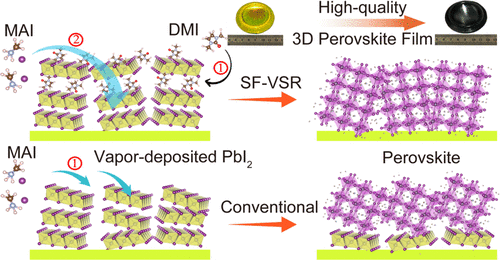当前位置:
X-MOL 学术
›
ACS Appl. Mater. Interfaces
›
论文详情
Our official English website, www.x-mol.net, welcomes your feedback! (Note: you will need to create a separate account there.)
Surface-Orientation Elimination of Vapor-Deposited PbI2 Flakes for Efficient Perovskite Synthesis on Curved Solar Cells
ACS Applied Materials & Interfaces ( IF 9.5 ) Pub Date : 2021-09-14 , DOI: 10.1021/acsami.1c12283 Ziyi Li 1 , Jinzhao Li 2 , Huanqi Cao 1 , Yicheng Qian 1 , Jianyong Zhai 1 , Yuan Qiu 1 , Liying Yang 1 , Shougen Yin 1
ACS Applied Materials & Interfaces ( IF 9.5 ) Pub Date : 2021-09-14 , DOI: 10.1021/acsami.1c12283 Ziyi Li 1 , Jinzhao Li 2 , Huanqi Cao 1 , Yicheng Qian 1 , Jianyong Zhai 1 , Yuan Qiu 1 , Liying Yang 1 , Shougen Yin 1
Affiliation

|
Vapor deposition of perovskite solar cells (PSCs) has attracted considerable interest for its dry processing characteristics. However, a two-step sequential vapor deposition method suffers from ineffective conversion of PbI2 to perovskite with reasons still unclear. In this report, we carefully investigated the crystallization orientation of PbI2 films deposited by physical vapor deposition via synchrotron grazing-incidence wide-angle X-ray scattering (GIWAXS) and observed an asymmetric scattering pattern with respect to the qz-axis. The observed oriented morphology and texture hinder the diffusion of MAI molecules in the PbI2 films synthesized by vapor deposition, resulting in over 15% PbI2 remaining at the buried interface after reaction with MAI vapor. As a result, the MAPbI3 synthesized in this way was also highly oriented, especially in the surface layers. Surface fumigation (SF) step was introduced to decrease the orientational anisotropy of PbI2, which successfully breaks the diffusion barriers of MAI molecules by forming a complex layer on the PbI2 surface with polar solvent vapors, like dimethyl sulfoxide or 1,3-dimethyl-2-imidazolidinone. We infer that the SF treatment changes the vapor–solid reaction mechanism from reaction–crystallization to dissolution–recrystallization, which largely promotes the conversion of PbI2 to perovskite. Defects were reduced in perovskite synthesized in this way, and a p-i-n device with 19.56% efficiency was fabricated, which is among the highest efficiencies reported for sequential-vapor-deposited PSCs. Notably, this method enables the fabrication of conformal perovskite layers on uneven substrates. An exemplary PSC showing efficiency of 8.93% was fabricated on a precurved substrate. We believe that the method is applicable to the fabrication of tandem or curved PSCs that are compatible with wearable or building/autocar-integrated photovoltaics in the future.
中文翻译:

用于在弯曲太阳能电池上高效合成钙钛矿的气相沉积 PbI2 薄片的表面取向消除
钙钛矿太阳能电池 (PSC) 的气相沉积因其干法加工特性而引起了人们极大的兴趣。然而,两步顺序气相沉积方法存在 PbI 2向钙钛矿转化效率低的问题,原因尚不清楚。在本报告中,我们仔细研究了通过同步加速器掠入射广角 X 射线散射 (GIWAXS) 物理气相沉积沉积的 PbI 2薄膜的结晶取向,并观察到相对于q z轴的不对称散射模式。观察到的取向形态和纹理阻碍了 MAI 分子在气相沉积合成的 PbI 2薄膜中的扩散,导致超过 15% 的 PbI 2与 MAI 蒸气反应后留在掩埋界面。结果,以这种方式合成的MAPbI 3也是高度取向的,尤其是在表面层中。引入表面熏蒸 (SF) 步骤以降低 PbI 2的取向各向异性,通过在 PbI 2表面上形成复杂层与极性溶剂蒸气(如二甲基亚砜或 1,3-二甲基)成功地打破了 MAI 分子的扩散障碍-2-咪唑烷酮。我们推断SF处理将气固反应机制从反应-结晶转变为溶解-重结晶,这在很大程度上促进了PbI 2的转化到钙钛矿。以这种方式合成的钙钛矿中的缺陷减少了,并且制造了效率为 19.56% 的 pin 器件,这是顺序气相沉积 PSC 报告的最高效率之一。值得注意的是,这种方法能够在不平坦的基板上制造共形钙钛矿层。在预弯曲基板上制造了显示 8.93% 效率的示例性 PSC。我们相信该方法适用于未来与可穿戴或建筑/汽车集成光伏兼容的串联或弯曲 PSC 的制造。
更新日期:2021-09-29
中文翻译:

用于在弯曲太阳能电池上高效合成钙钛矿的气相沉积 PbI2 薄片的表面取向消除
钙钛矿太阳能电池 (PSC) 的气相沉积因其干法加工特性而引起了人们极大的兴趣。然而,两步顺序气相沉积方法存在 PbI 2向钙钛矿转化效率低的问题,原因尚不清楚。在本报告中,我们仔细研究了通过同步加速器掠入射广角 X 射线散射 (GIWAXS) 物理气相沉积沉积的 PbI 2薄膜的结晶取向,并观察到相对于q z轴的不对称散射模式。观察到的取向形态和纹理阻碍了 MAI 分子在气相沉积合成的 PbI 2薄膜中的扩散,导致超过 15% 的 PbI 2与 MAI 蒸气反应后留在掩埋界面。结果,以这种方式合成的MAPbI 3也是高度取向的,尤其是在表面层中。引入表面熏蒸 (SF) 步骤以降低 PbI 2的取向各向异性,通过在 PbI 2表面上形成复杂层与极性溶剂蒸气(如二甲基亚砜或 1,3-二甲基)成功地打破了 MAI 分子的扩散障碍-2-咪唑烷酮。我们推断SF处理将气固反应机制从反应-结晶转变为溶解-重结晶,这在很大程度上促进了PbI 2的转化到钙钛矿。以这种方式合成的钙钛矿中的缺陷减少了,并且制造了效率为 19.56% 的 pin 器件,这是顺序气相沉积 PSC 报告的最高效率之一。值得注意的是,这种方法能够在不平坦的基板上制造共形钙钛矿层。在预弯曲基板上制造了显示 8.93% 效率的示例性 PSC。我们相信该方法适用于未来与可穿戴或建筑/汽车集成光伏兼容的串联或弯曲 PSC 的制造。



























 京公网安备 11010802027423号
京公网安备 11010802027423号